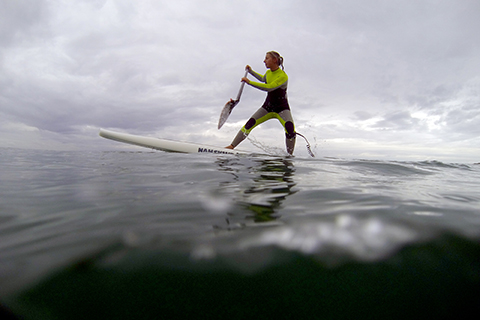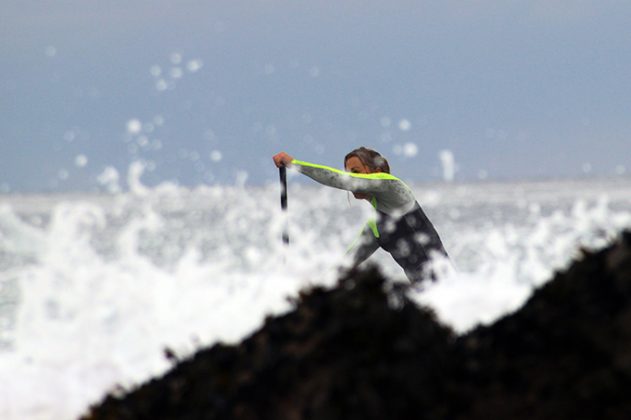PADDLE SCIENCE #6 –
WARM UP FOR WINTER
Words – Kate Starling
Have you ever seen a lion warm up before they sprint and chase their prey? Is that ankle injury you’ve recently picked up because you didn’t stretch prior to your workout? And are you feeling sore after getting off the water because you failed to warm up?
What you should and shouldn’t be doing prior to a SUP session or any other form of exercise can be downright confusing. Should you do a warm up and if so, what kind of warm up should you aim to do?
Why Warm Up in the First Place?
If you’ve ever stood on a cold wintery beach wondering whether or not you should bother to warm up then consider this: warming up prior to exercising can improve performance by seventy-nine percent. Warming up has been shown to:
• Increase the speed of muscle contraction and relaxation, making your muscles more efficient.
• Reduce muscle stiffness. This particularly applies to dynamic stretching which we’ll talk about in a bit.
• Improve oxygenation to muscles as haemoglobin within the blood releases oxygen more readily at higher muscle temperatures. This oxygen is critical for muscle contraction.
• Increase the speed of nerve impulses.
• Promote motor unit recruitment so that your muscle contraction will be stronger when you start to increase the intensity of your workout.
• Increase blood flow within your soft tissues which helps to increase oxygen to your muscles.
• Boost your heart rate so that it’s at a workable rate for starting your SUP session.
• Mentally prepare you and improve your focus for whatever you’re planning to do when out on the water, be it sprint training, SUP surfing or racing.
A warm up should aim to increase your body temperature by about two to three degrees. However, why you do it and what you do is important to maximise its benefits.
Should we be Stretching to “Warm Up”?
A popular idea is that a warm up should typically include stretching. In the past, static stretching, where a muscle is held in position for a length of time was advocated by many prior to exercising. However, research has found that if you hold a static stretch for up to sixty seconds it can result in reduced force and power production. In other words, static stretching can impede your athletic performance. The study does however report that static stretches of up to thirty seconds are “not detrimental”. This sounds great! However, just because shorter stretches won’t do you any harm, there’s no evidence to show that they actually help. Additionally, it’s unlikely that static stretching of, for example, your quads or hamstrings is in any way going to replicate any of the movement patterns you’ll need when you’re out on the water. Any warm up needs to be relevant to what you’re about to do so static stretching isn’t that great before you SUP.
A better way to stretch can be through dynamic stretching which can help to boost performance by reducing muscle and joint stiffness and improving flexibility. It helps to prepare your joints for movement and encourages optimal muscle activation. Dynamic stretches should take your arms and legs through their entire range of movement prior to heading out on the water. Don’t however just swing your limbs willy-nilly in all directions. Instead, focus on constant and controlled movements, gradually working into an increased range of movement. Good dynamic stretches for SUP include those which engage the muscles and movements needed for SUP:
• Knee rotations. Stand with your feet and knees together and slightly bend your knees. Place your hands on your thighs. Slowly circle at the knee in a clockwise then anticlockwise direction. Repeat 12 times in both directions.
• Arm Circles. Stand nice and tall. Lift your arms out to the sides to ninety degrees with your thumbs pointing upwards. Circle your arms forwards and back. Repeat 12 times in both directions. Then, change your arm position by pointing your thumbs downwards and repeat.
• Arm rotation. Stand ice and tall. Lift your arms out to the sides to ninety degrees and bend your elbows to ninety degrees, palms facing forwards. Rotate from the shoulder bringing your hand down so that your palms face behind you. Repeat 12 times.
• Lunges with trunk rotation. Step forwards with your left leg. Keep your back straight and rotate your trunk towards the left. Repeat 12 times. Then repeat on the opposite side.
• Lunge and reach. Step into your lunge position as above, left leg forwards. Reach your right arm above your head and then stretch and reach your arm towards your left leg. Repeat 12 times. Then repeat on the opposite side.

Preventing Muscle Soreness Post SUP
Feeling achy and sore after you last headed out on the water? This is often due to muscle pain or ‘delayed muscle onset soreness’ (DOMS). This can occur anywhere in the body and will typically occur between 6-48 hours post exercise although this varies between individuals. It’s believed to be caused by micro-trauma or tiny muscle tears at a cellular level which can lead to inflammation.
It’s often thought that warming up prior to exercising can help to reduce muscle pain or DOMS. Some research indicates that warming up may slightly reduce muscle pain post exercise. However, overall, the ability of a warm up to significantly reduce DOMS post exercise is largely unsupported. A warm up may therefore help to reduce muscle pain and discomfort a little. However, despite a decent warm up, you may well still feel those muscles long after your wetsuit’s dried. Perhaps more importantly, it’s worth noting that the level of DOMS you experience may well reduce the more your body gets used to moving in a particular way. Therefore, if you gradually start to SUP more regularly or, for example, interval train more often, your level of muscle pain post session should start to decrease as your body adjusts to the relevant movement patterns.
“Warm up the mind. By the time you pick up the pace or go to do your first kick turn, the movements involved should feel second nature to you. ”
Warm Ups and Injury Prevention
Warming up and stretching can help to prevent injury – right? In fact, the research behind this is inconclusive at best and tends to show that static stretching does not reduce injury risk although dynamic stretching may. However, consider this. The majority of injuries occur once you have warmed up already. Chances are you don’t feel that tweak in your shoulder when you’re paddling until you’ve been out on the water for a while, well after that initial ‘warm up’ period. Typically, injuries also occur when the soft tissues are overloaded. Therefore, problems such as cramp and muscle tears occur often due to overexertion rather than by being stretched beyond their range of motion. Injuries can also occur due to a muscle imbalance within the body. If certain muscles are not performing properly, other muscles will compensate for this and perform functions they are not designed to do. If these compensating muscles are overworked, for example during a long paddle or a sprint session, cramp or injury can occur. Warming up prior to SUPing will not therefore reduce the chances of this happening as it does nothing to restore the underlying muscle imbalance.
With all this in mind, what should you do? Too much static stretching can reduce your performance on the water whilst inconclusive evidence exists to support holding shorter static stretches whilst you’re on the beach or in the car park. Dynamic stretching is supported and should be included as part of your warm up. However, either way, it’s unlikely that any stretching will reduce your injury risk or DOMS post SUP session.
Overall, your warm up should be pretty simple. Aim to be specific to SUP and consider the following:
• Do Lighter Versions of the Workout
Rather than warming up by doing static land based stretches and non-specific movements, jump onto your SUP board and start off gently. A slow paddle for a few minutes before you pick up the pace and work a bit harder will help your joints and soft tissues adjust and get used to the movement patterns and forthcoming work without being overloaded. It also enables you to focus on your form and quality of movement so that you can get your paddle stroke and body position right from the outset, thus helping to stave off injury.
• Get Warm
As you start to gently paddle, focus on warming your body up. Warm muscles are less viscous and receive increased blood flow, nutrients and oxygen. This enables them to contract faster making them far more efficient than cold muscles. Focus on increasing your breathing rate and building a gentle sweat to ensure that you are physically warm before your SUP session increases in intensity.
• Warm Up the Mind
Warming up is not just about your physical joints, muscles and soft tissues etc. By the time you pick up the pace paddling or go to do your first kick turn, the movements involved should feel second nature to you. This means that you are mentally prepared and the relevant neural pathways are established so that your central nervous system is prepared to facilitate the movements you want to do.
• Keep an Eye Out for Overcompensation
When you first stand up on your board and hold your paddle, think about how your body moves and feels. Does your shoulder feel stiff as you shoulder stack? Does your knee feel sore as you step back onto your board? Your body should feel ready to perform without stiffness or overcompensation from other body parts. Focus on which parts of your body feel tight or overworked and address these off the water.
• Be Pre-Emptive Over Injury
This leads on from point four. Identify any particular areas which require attention and then aim to prevent muscle injuries by working on any muscle imbalances when off the water.
• Follow the Lion
Lions don’t stand in the savannah dynamically swinging their legs before sprinting to catch their prey. However, in the same way as your dog, you’ll often see them get up from a long snooze and stretch their backs out in that classic downward dog pose. Animals never put time aside to stretch they simply stretch periodically throughout the day. Notably, it’s fair to say that animals don’t sit for eight hours in a chair every day and are not sedentary or overweight. They walk and simply move around more than we do meaning that they’re already warm when dinner appears on the horizon. Incorporating regular stretching and movement into your day is the most effective and best way of maintaining a limber body so that you move more optimally during your next SUP session. It will help to maintain your mobility and flexibility enabling you to get out SUPing without stiffness or pain. SUP
Kate is a physiotherapist and standup paddler. Reach her at www.newquayphysio.co.uk


